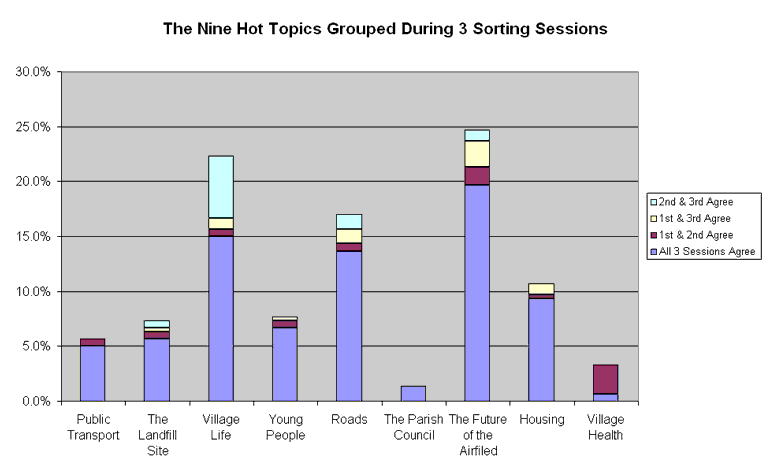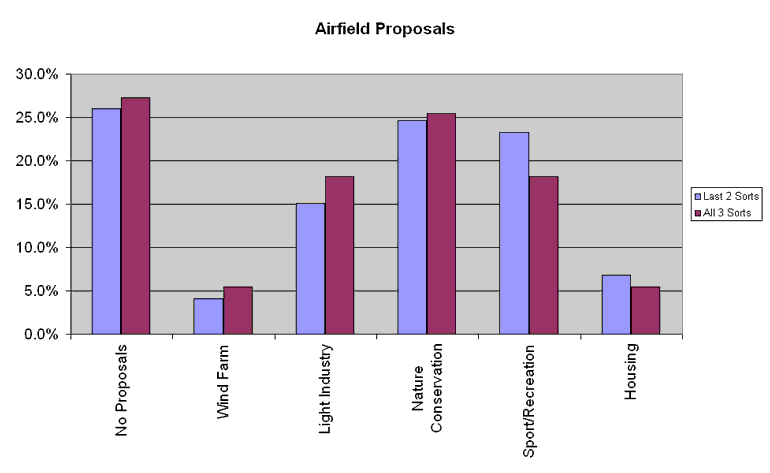Appendix 1: Data Collection & Analysis
Contents
A survey sheet was produced titled
“Hot Topics Needed For Parish Plan”. It asked for the views of the
recipients in the form of “Hot Topics” about issues they saw as
most important in terms of a Parish Plan. Short statements about the three most
important issues were requested that told why they saw the issue as important.
Although three statements were suggested, the replies were not limited and recipients
were free to write as much or as little as they pleased.
The Parish Plan Steering Group (PPSG) decided that 25% (87) of the households in the Parish should be surveyed. The sampling technique used was to select every 4th dwelling from the addresses in the electoral role of the Parish. The Parish was divided into 4 locality areas:
- Bishampton Village
- Bishampton Rural
- Throckmorton
- Tilesford
Where a particular household declined to complete the survey or was vacant, the next dwelling on the Electoral Role was visited instead.
Six members of the PPSG were assigned as contacts for specific areas or part thereof. These contacts distributed the survey sheets according to the distribution plan and collected them over the succeeding 2-week period.
In addition local organisations within the parish were contacted for their views. Replies from these recipients were classed as from a group designated:
- Organisations
In all, 88 survey sheets were returned as follows:
Area |
Number |
As
a percentage of households |
| Bishampton Village | 56 |
26 |
| Bishampton Rural | 9 |
|
| Throckmorton | 10 |
24 |
| Tilesford | 9 |
|
| Organisations | 4 |
Table 1: Survey sheets returned by area
The returned surveys were numbered and the statements thereon transcribed to an MS Access97 database using relational database techniques. The survey sheet number was recorded in the database but details of the authors were not. Also entered was the area each survey sheet originated from.
The statement text for each survey sheet was divided into “Comments” and stored in separate records. Each of these records was allocated a “Comment” identifier.
To further disassociate the original survey sheet from individual “Comments” for analysis, a random number generator was used to “shuffle” the “Comments” and allocate each one an identity called “Card No.”. Traceable links back to the original survey sheet number were maintained.
This method resulted in a set of
cards each containing one comment, which are the cards referred to in ‘card
sorts’.
Consultation meetings were held at Bishampton on 8 January 2004 and at Throckmorton
on 9 January 2004. At these meetings, proposals for the airfield were displayed
and visitors invited to express their views. Two mechanisms were used to collect
visitors’ views:
- Write their views on Post-It slips and put them in pockets by the appropriate display
- Indicate their answer to specific questions/options by signing an appropriate sheet on the appropriate display
These data were also recorded in the database.
Two sorting procedures were employed with the data.
To date six “Sort” activities have been carried out on the Hot Topic Survey data.
In order to establish an initial impression of the important issues from the survey a first “Sort” was carried out on 7 September 2003 This resulted in the identification of the nine hot topics.
To date five further sorts have: all are detailed in Table 1. Four different sorters (in sort 1, this a pair working together) have sorted the comments, acting independently of each other.
Sort
ID |
Date |
Description |
Sorter(s) |
1 |
7 Sep 03 |
First Sort using cut copies of original survey returns. Contained 303 “Comments” | MA &
RO |
2 |
18 Dec 03 |
Second sort using complete set of “Cards” (330). Results used to check reliability of Sort 1. | EC |
3 |
18 Dec 03 |
First sub-sort of Cards from Sorts 2 categorised as "Airfield", to identify proposals | EC |
4 |
19 Dec 03 |
Third sort using complete set of “Cards” (330). Results used to check reliability of Sorts 1 & 2. | LG |
5 |
19 Dec 03 |
Second sub-sort of Cards categorised as "Airfield" to identify proposals. | LG |
6 |
20 Dec 03 |
Third sub-sort of Cards categorised as “Airfield” to identify proposals | BD |
Table 4: Sorting activities
To date no sorting activities have been carried out the Post-It views collected at the Consultation meetings held in January.
3.3 Resulting sort categories from the Hot Topics Survey
– the ‘Nine Hot Topics’
The sorting activities yielded nine major categories ranked in the following priority order:
Figure 1 shows the sort results as a percentage of the total number of “Cards” and illustrates the level of agreement between the three topic sorts.

Figure 1: The nine hot topics
The sorting of the proposals for the airfield yielded 5 categories in the following
priority order:
Figure 2 shows the results of the airfield proposal sorting activities. Since
the last two sorts (IDs 5 & 6) used the same “Card” set those
results have been grouped together while the result of the all three sort (IDs
3, 5 & 6) is illustrated separately.

Figure 2: Proposals for use of the airfield